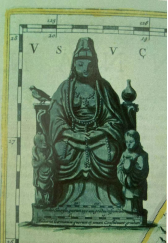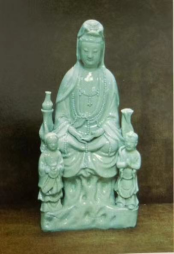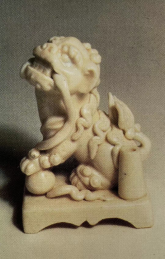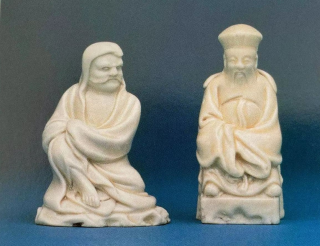来源: 发布时间:2021-07-02 16:23:00
[外国人眼中的“中国白”(连载)]
编者按:由柯玫瑰(Rose Kerr)、约翰•盖尔(John Ayers)所著《中国白——德化白瓷》(Blanc de Chine—porcelain from Dehua)于2002年经新加坡亚洲文明博物馆出版,是继唐纳利《中国白——福建德化瓷》之后的一本专门研究德化白瓷的专著,影响甚为深远。
该书收录的都为国外研究德化白瓷的知名学者所撰写德化白瓷研究资料。包括柯玫瑰的“德化器物款识介绍”,海蒂(Heidi Tan)的“鉴赏家探访”,约翰•盖尔的“中国白的影响”,何翠媚(Chuimei Ho)的“考古眼光中的中国白”,郭勒逊(Kenson Kwok)的“德化雕塑结构的一点看法”,埃娃•施特勒伯(Eva Strober)的“德累斯顿的斯特朗大帝收藏的德化瓷”,以及附录介绍等七个部分,从不同角度介绍了德化白瓷。与此同时,该书收录的160件德化窑精品,为Hickley家藏,后捐赠给新加坡亚洲文明博物馆,是了解、品鉴、研究德化白瓷不可多得的艺术精品。
本栏目将定期精选出相关代表性文章进行翻译,以飨读者。然而,由于作者水平的局限,翻译过程中难免有所错漏,不足之处敬请各位读者提出宝贵意见。
Blanc de chine:some reflections by John Ayers
中国白的影响(四)——约翰 盖尔
(翻译: 孙延燕)
Alongside this Guanyin model may be set Donnelly's next dating marker; an early European engraving representing another Guanyin group which may confidently be e iden tified as a blanc de Chine one(Fig. 17). The print appears in the border of one page of the Chinese section of W and J. Blaeu's Nieuw Atlas, first published in Amsterdam in 1655, however, according to Phillip Allen, who kindly obtained the illustra tion for me, this identical printing in fact comes from the 667 edition. The maps were taken over from a preceding wor rk by the Jesuit father Martin Martini, who is said to have left China in 1651.
在这个观音模型旁边可能是唐纳利的下一个纪年器物,它是一个早期的欧洲版画代表了另一个观音团体,可能自信地被认为是中国白瓷器(图17)。这张印刷品出现在布劳厄的《新地图集》中文版的一页边上,1655年首次在阿姆斯特丹出版,然而,根据菲利普 • 艾伦的说法,他帮我弄到了这张插图,这张完全相同的印刷品实际上来自1667的版本。这些地图是从耶稣会教士马丁•马提尼之前的工作接管过来的,据说他在1651年离开了中国。

(Figure 17: Guanyin:engraving from Blaeu’s Nieuw Atlas,1655. 图17: 观音: 版画依据布劳厄的《纽约地图集》,1655年。)
The engraving shows Guanyin seated on a rocky throne and accompanied by her aco- lytes, Shancai and Longnu, below; to left and right are the vase of heavenly dew and a bird. Donnelly was unable to trace any porcelain original corresponding to this, but Phillip Allen has kindly allowed me to show a group now in his possession which is unquestion ably a very close match -and which thus represents a model already existing in 1655, if not indeed before 1651(Fig. 18). Here is the same pose with hands joined on the lap and the same arrangement of the draperies and mantle, the same jewelled pendants, the same base, also the two acolytes, and above these the nectar flask on her right and the bird on the left except that in the engraving process these were reversed On Mr Allen's figures the bird is unfortunately missing, broken off, but curiously enough, very soon after seeing this piece another of our members, Mr Wikramaratna, was fortunate enough to find one in whic the bird was complete, although this time the flask was missing. once again the deity sits face on to the viewer: it is a form of presentation repeated in many groups In the second half of the century; but a certain stumpiness here fits well with our cencept of the earlier modelling type.
这幅版画显示,观音坐在一个石制的宝座上,旁边还有她的助手善财和龙女,左右各有一个装着天露的花瓶和一只鸟。唐纳利找不到任何与之相对应的瓷器原件,但菲利普•艾伦热心的向我展示了一组现在他手中的瓷器,毫无疑问,它们非常接近,因此代表了一个早在1655年就存在的模型,如果不是在1651年之前的话(图18)。这是同样的姿势,双手放在膝盖上,布料和斗篷也是同样的排列,同样的珠宝吊坠,同样的衬衣,还有两个助手,在这些上面,她右边的花蜜瓶和左边的鸟,除了在雕刻过程中,这些在艾伦先生的雕像上倒过来,不幸的是,鸟不见了,断了,但奇怪的是,在看到这个雕像之后不久,我们的另一位成员,维克拉马拉特纳先生,有幸找到了一个有一只完整的鸟,虽然这一次,这只花蜜瓶不见了。再一次,神坐在面对观众:这是一种表现形式重复在多个群体在后半部分但是这里的某些粗糙与我们早期的造型类型的概念很吻合。

(Figure 18: Guanyin enthroned. 1650. Phillip Allen Collection. 图18: 加冕的观音。1650年。菲利普·艾伦收藏。)
For the 1640s and perhaps a little earlier we now have the additional evidence of the Hatcher wreck, which was of course unknown to Donnelly; just a few small figure models were found and these are by no means of fine quality. A small lion on a plinth, forming a taper-holder, exemplifies their characteristics such as the somewhat creamy colour and Blaeu rather heavy treatment of everything (Fig 19): notice also the open-cut, arcade-like base, which before long will be more plainly treated. The finds also include a second variety of somewhat larger lions raised on higher bases: these too are rather crudely worked, and to judge from the photograph the glaze seems to be rather dry. It is worth noting here that Donnelly describes and illustrates another pair of lions in Hong Kong which are actually dated to the year 1645. Another Hatcher wreck model is a small water dropper for the writing-table in the form of a figure in a scholars hat riding on a fish: this is the carp that climbs the rapids, and so provides a popular rebus of success in the official examinations. Originally designed for Chinese use, such items were no doubt brought back from China by Westerners as curios; and these Hatcher pieces may in fact be no more than a sample of what had reached Europe by the mid-seventeenth century.
17世纪40年代,或许更早一点,我们现在有了哈彻号残骸的额外证据,当然唐纳利并不知道,只发现了几个小人瓷塑,这些绝对不是高质量的。一只小狮子站在基座上,形成一个烛台,体现了它们的特点,例如乳白色的颜色,以及对一切事物的浓重处理(图19) : 还要注意露天切割的拱廊式底座,不久这种底座就会得到更清晰的处理。这些发现还包括第二种较大的狮子,它们的底部较高,雕刻也相当粗糙,从照片上看,釉料似乎相当干燥。这里值得一提的是,唐纳利描绘了香港的另一对狮子,它们实际上可以追溯到1645年。哈彻号的另一个残骸瓷塑是一个为书写做的小水滴,一个人物坐在一条鱼的学帽上: 这是鲤鱼爬上急流,所以提供了一个在官方考试中鱼跃龙门的预言。这些原本是为中国人设计的,毫无疑问是西方人从中国带回来的古玩,而这些哈彻号瓷器实际上可能不过是17世纪中叶到达欧洲的东西的一个样本。

(Figure 19: Lion taper-holder, from south China sea.1643. Christie’s. 图19: 狮子烛台,来自南中国海1643年。佳士得。)
Figure 20 shows two small figures, one at least of them an exported type, which share in much of this simple, broad treatment. Bodhidharma, the Buddhist patriarch, who appears on the left, is really a rather fine figure both in modelling and in the finishing of the bearded face, as well as in the bold sweep of the robe. The bearded dignitary on the right has the now familiar high-backed throne and an arcaded footstool. Both of these were indicated in the Marchant exhibition where David Freedman was, I think, well justified in dating them in the catalogue to c 1640. Two slightly different versions of the'dignitary one without base, the other with a cruder one -are at Burghley House, where it was inventoried in 1688, and in the Victoria and Albert Museum; perhaps all these were made within a period of twenty years or so.
图20显示了两个小型雕塑,其中至少有一个是出口的,它们分享了大部分这种简单、宽泛的处理方法。菩提达摩,出现在左边的佛教元老,在造型和胡子脸的修饰上,以及在长袍的粗线条上,都是一个相当不错的人物。右边这位大胡子高官,坐在我们熟悉的高背宝座和拱形脚凳上。这两个都在马尔尚展览中有所提及,我认为,大卫•弗里德曼在1640年的目录中,很好地证明了它们的年代。两个稍微不同的版本,一个是没有基座的高僧,另一个是粗俗的高僧——分别存放在伯利庄园,1688年入库;和维多利亚和阿尔伯特博物馆里,也许所有这些都是在二十年左右的时间里完成的。

(Figure 20: Left.Bodhidharma. height .6cm. Right. Bearded figure. Height 9.4cm.1620-50. S.Marchant and Son. 图20: 左侧,菩提达摩,身高6厘米。右侧,胡须的瓷雕。高9.4厘米,1620-50年。马钱特和他的儿子。)
The next document for dating figures is a model formerly in the Sneddon collection and shown in an exhibition of blanc de Chine assembled several years ago by Bluett and Sons. Its inscription reads: 'made by Lin Yang with respect and clean-washed hands on a lucky morning in the second spring month of the fifty-eighth cyclical year which in this case can hardly be other than 1681. This is not greatly different in style from the late-seventeenth-century export Guanyin with which I began; and with such pieces it gives some positive clues to the sort of development that had been taking place over the previous thirty or forty years in examples of this quality.Characteristically the figure is rather tall and slender, and Guanyin is represented here standing on a small mound of clouds; the robes are more intricate in their folds than before and are made with sharply cut projections.
下一个关于年代测定的证据是一个瓷塑,以前在斯内登收藏中,而且几年前在布鲁特及其后裔组织的中国白展览中展出。题字中写道:“五十八周年第二个春月的一个幸运的早晨,林阳敬重地洗手而作,在这种情况正是1681年。这与我开始的17世纪晚期的外销观音的风格没有很大的不同,通过这些作品,我得到了一些可以看出在过去的三十、四十年间观音的发展的积极线索。典型的形象是相当高和苗条,观音在这里站在一团堆积云上;长袍的褶裥比以前更加复杂,而且切割更加突出。
An especially interesting group of figures are those which were not only made for export, but on account of their subjects, can be seen to have been specially commissioned for the West. At Jingdezhen this kind of specialised production was already in progress in the sixteenth century, while the Dutch records from Batavia show that wooden models for forwarding to the factories were supplied at least as early as 1635. It is quite possible there fore that similar instructions were also sent to Dehua; and a significant period for this might well be the years between the fall of the Ming in 1644 and 1662, when the Dutch base in Formosa off the Fujian coast was seized by Coxinga.Catholic Portugal on the other hand, seems a more likely instigator of figures such as the Guanyin-like Madonna and Child in the British Museum-which was perhaps based on a model in ivory produced for example at the settlement of Goa, if not indeed made for the Spanish in Manila. Possibly some models of this kind ought to be dated some decades earlier than the 1680s.
一组特别有趣的人物,不仅是为了出口而制作的,而且因为他们的题材,可以看出是专门为西方制作的。在景德镇,这种特殊的生产在16世纪就已经开始了,而来自巴达维亚的荷兰记录显示,运往工厂的木制模型至少早在1635年就有了。很有可能在此之前,德化也收到了类似的指示,而这一个重要时期很可能是从1644年明朝灭亡到1662年之间的几年,当时荷兰在福建沿海的台湾基地被科辛加占领。另一方面,信奉天主教的葡萄牙似乎更像是大英博物馆中类似观音的与孩子的圣母的发起者——它可能是基于一个象牙制品的模型,例如在果阿定居点生产的象牙,如果不是真正为其制作的话是马尼拉的西班牙人。可能有些这种模型的年代,应该比17世纪80年代早几十年。
I have not yet mentioned the finest figures of all those on which the special fame of the Dehua model. lers is ultimately based. So far as we know, such things did not reach the west at all until the period when they had alrea eady become antique, and the best of our late.Ming group -the Caishen of 1610 and so on-are presumably also in this category. The le finer figures are invariably dated Ming in Chinese circles and while this view has been consistently doubted here in the past, we may now begin to see rather more truth in it.
我还没有提到最终给德化瓷塑带来特殊声誉的那些精美瓷塑。据我们所知,这些东西直到它们已经成为古董的时候才到达西方;而最好的晚明瓷塑,是1610年的财神及其它,大概也属于这一类。在中国人的文化里,好的瓷塑总是被认为是明代的,虽然这种观点在过去一直受到质疑,但是我们现在可能开始看到更多的真相。
The subject is a vast one, but let us look briefly at one or two models that bear the most famous of all Dehua potters ma rks: that of He Chaozong. History does not record who, or what, He Chaozong was, al- though Donnelly observes that the mark is found on at least two hundred figures, and in many forms. We need not believe in all of these and no doubt a fair number are versions of a later period. Donnelly's suggested date for He Chaozong's activity is the period between 1665 and 1695, one of thirty years or so, but-if indeed he is to be considered as a single master modeller-this now seems improbably late.
这是一个庞大的主题,但让我们简单地看一下一两个最为有名,带有德化瓷塑家何朝宗标志的瓷塑。历史没有记载何朝宗是谁,尽管唐纳利注意到,至少有200个瓷塑身上有这个标记,而且有多种形式。我们不需要相信所有这些,毫无疑问,有相当数量的是后期版本。唐纳利建议何朝宗活动的时间是1665年至1695年,大约30年左右,但是——如果他真的被认为是唯一的瓷塑大师——这现在看来似乎有些不可思议。
The model in Figure 21 represents Wenchang, the Star God and patron of literary men; standing some 15 inches high, it is a model of impressive dignity and power, and perhaps the finest of all those shown in Marchant's exhibition. The high, rocky throne is already familiar and so is the subject: we have seen him in a smaller, early seventeenth-century group. This does not, of course, date the model but here other features such as the weight potting and rich, ivory-cream material and glaze are significant. The modelling has bo the proportions a little plump if not so pronouncedly so as in the earlier dated pieces, the folds of the robes natural and without exaggeration, the head and hands not overworked. A date more of the early to mid-century seems appropriate and Marchant's c1640 appears not unreasonable.
图21中的代表文昌帝君,天神和文人守护神; 站立约15英寸高,是一个令人印象深刻的尊严和力量的瓷塑,也许是所有在马尔尚的展览中展示的最好的模型。高耸的岩石王座已经为人们所熟知,主题也是如此:我们曾在17世纪早期的一个较小的群体中见过他。当然,这并不能确定瓷塑的年代,但是这里的其他特征,例如陶土的重量和丰富的象牙奶油材料和釉料都是重要的。瓷塑有一定的宽度和简洁性,身材比较丰满,虽然不像早期的作品那么显眼,袍子的褶皱自然,没有夸张,头部和手部也没有过分累赘。断代在本世纪早期到中期更合适,而马钱特的1640年看起来也不是不合理。

(Figure 21: Wenchang enthroned. Height 38.8 cm. Marker of He Chaozong, c 1620-50 Koger Collection. 图21: 加冕的文昌帝君,高度38.8厘米。何朝宗,1620-50年,克罗格收藏。)
Fingures such as these are greatly distanced from those in the export class by their sheer quality as sculpture: a distinction that resides in their artistic conception as much as in their quality execution. The models were, however, designed to undergo a great deal of subsequent handwork including not just the removal of mould -ines but a sharpening-up and fining of everything -facial features,hands, and the lines of the robes, which are often substantially undercut; the result stands on an altogether different plane of achievement.
像这样的瓷塑与之前出口类别的瓷塑就单纯质量而言有很大不同:区别在于它们的艺术构思和质量。然而,这些瓷塑被设计用来进行大量的后续手工制作,不仅包括去除模线,还包括对所有东西——面部特征、手和长袍的线条——进行锐化和精雕细琢,这些线条经常被大幅削弱,其结果是所成就的作品完全不同。